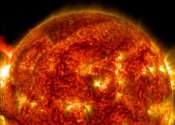Japan's moon lander comes back to life
Japan's moon lander has come back to life, the space agency said Monday, enabling the craft to proceed with its mission of investigating the lunar surface despite its rocky start.

Japan's moon lander has come back to life, the space agency said Monday, enabling the craft to proceed with its mission of investigating the lunar surface despite its rocky start.
Space Exploration
Jan 29, 2024
0
1372

Solar flares—violent explosions on the surface of the sun—can send blasts of radiation hurtling toward Earth. While the planet's magnetic field protects humans on the surface, powerful solar flares can disable satellites, ...
Space Exploration
Jul 31, 2020
135
326

Artificial Intelligence may be just the thing to accelerate spray-on solar cell technology, which could revolutionize how consumers use energy.
Materials Science
Dec 16, 2019
0
1823

(Phys.org) —At large-scale solar plants, keeping the surfaces of solar panels free from dust, sand and bird droppings is not just a matter of finicky housekeeping. It can be a matter of plant profitability. Dirty panels ...

Following the termination of the flight of the balloon-borne solar observatory Sunrise III on July 10, team members have reached the landing site and found the observatory's science payload largely intact. According to current ...
Astronomy
Jul 22, 2022
0
37

Scientists at the Universities of Birmingham, Bristol and Colorado, Boulder have moved a step closer to developing the next generation of data storage and processing devices, using an emerging science called skyrmionics.
General Physics
Apr 1, 2019
1
661

The amount of solar radiation passing through Earth's atmosphere and reaching the ground globally peaked in the 1930s, substantially decreased from the 1940s to the 1970s, and changed little after that, a new study has found.
Earth Sciences
Aug 26, 2013
29
0

A strong solar flare is blasting its way to Earth, but the worst of its power looks like it will barely skim above the planet and not cause many problems.
Space Exploration
Sep 10, 2014
80
0

There are only five bodies in our solar system that are known to bear rings. The most obvious is the planet Saturn; to a lesser extent, rings of gas and dust also encircle Jupiter, Uranus, and Neptune. The fifth member of ...
Astronomy
Mar 16, 2015
0
1021

Dr. Lu Xing, an associate researcher from the Shanghai Astronomical Observatory (SHAO) of the Chinese Academy of Sciences, along with collaborators from Yunnan University, the Harvard-Smithsonian Center for Astrophysics, ...
Astronomy
Jun 2, 2022
0
173